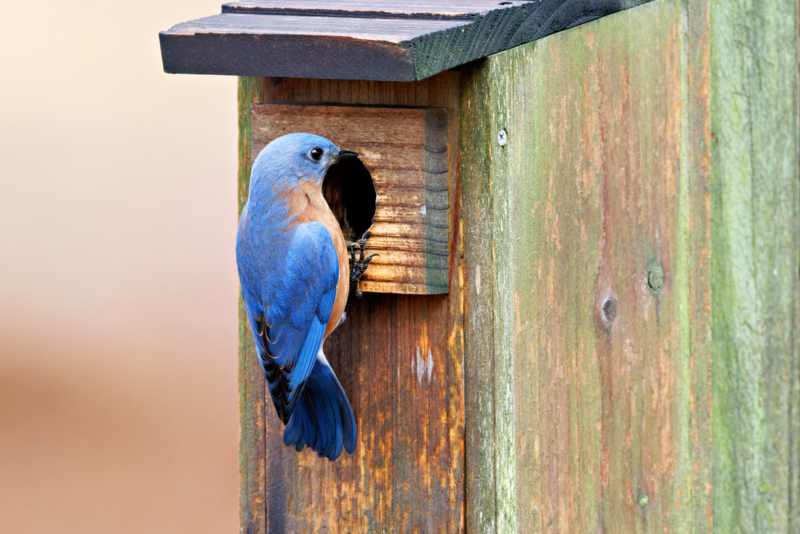As winter approaches, I check my birdhouses to make sure they are clean and ready for Eastern Bluebirds. Even though winters in Arkansas are usually mild, cold snaps, wind, and ice can still be tough on small birds. A properly prepared birdhouse gives bluebirds a safe place to roost when temperatures drop.

How I Prepare Birdhouses for Cold Weather
Before winter sets in, I remove old nesting material from each birdhouse. This helps reduce parasites and makes the box more inviting for winter roosting. I also check that the house is solid, dry, and properly mounted.
According to the Cornell Lab of Ornithology, Eastern Bluebirds may also use nest boxes outside the breeding season as shelter during cold weather, which is another reason I leave my birdhouses up year-round (Cornell Lab of Ornithology).
I use birdhouses designed for Eastern Bluebirds with an entrance hole around 1.5 inches. Wood or cedar houses work best because they provide insulation and breathe better than plastic or metal.
Placing the birdhouse where it gets morning sun can make a difference on cold days. A little warmth early in the day helps birds recover energy after a long night.
Helping Bluebirds Find Food in Winter
Shelter is only part of the equation. During winter, natural food sources are harder to find. I often supplement with mealworms and suet placed near the birdhouse. These foods are easy for bluebirds to digest and provide much-needed calories.
Keeping water available can also help during freezing weather. If temperatures allow, a shallow birdbath can be a valuable resource.
A Simple Way to Support Eastern Bluebirds
Preparing birdhouses for winter does not take much time, but it can make a real difference. Clean boxes, proper placement, and reliable food sources all help Eastern Bluebirds survive the colder months. Watching them use these shelters throughout winter is one of the small rewards of caring for backyard birds.
If you are unsure whether birdhouses should stay up after nesting season, I explain why keeping them in place all year can benefit birds in this post on why you should leave birdhouses up year-round.
Image Information:
- Date: 01/24/24
- Time: 9:03 AM
- Camera: Canon EOS R5
- Lens: Canon RF 100-500mm F4.5-7.1 L IS USM
- ISO: 8000
- Aperture: 8
- Shutter: 1/500
- Exposure Compensation: +0.7
- Focal Length: 500
- Program Mode: Manual

Hello Steve, although we don’t get bluebirds here in Crete I would love to put a birdbox in my garden but worry in case it attracts mice when they flick out the seed. My husband has two aviaries in the garden which seem to be o.k. whereas I would have to hang the birdbox from a tree. What do you think.
Regards Rita Roberts.
Dear Rita,
It’s wonderful that you want to attract birds to your garden, even though bluebirds aren’t native to Crete. While it’s true that bird feeders and birdhouses can sometimes attract mice, there are ways to minimize the risk and still enjoy the company of feathered friends.
Here’s my take on your concerns:
Mouse Attraction:
Aviaries vs. Birdhouse: Your husband’s aviaries likely attract fewer mice because they are enclosed and off the ground, making access difficult. A hanging birdhouse is more accessible, so there’s a slightly higher chance of attracting mice.
Minimizing the Risk:
Seed Choice: Avoid using sunflower seeds and opt for shelled peanuts, suet cakes, or millet. These are less messy and less appealing to mice.
Cleanliness: Regularly clean the area beneath the birdhouse to remove fallen seeds and nesting materials that might attract mice.
Location: Hang the birdhouse away from walls, fences, and trees that could provide easy climbing access for mice. Consider a pole with a squirrel baffle.
Alternative Food Sources: Seal up any potential food sources for mice around your garden, like pet food, compost bins, or garbage cans.
Additional Tips:
Birdhouse Type: Choose a birdhouse with a small entrance hole to deter larger animals like squirrels and potentially mice.
Native Species: Attract native birds by offering food and shelter they prefer. You can research bird species in Crete and choose a birdhouse suitable for their needs.
Monitor and Adapt: Keep an eye on the area around the birdhouse and adjust your approach if you see signs of mice activity.
Conclusion:
Attracting birds to your garden with a birdhouse is definitely possible, even with the potential for mice. By taking the above precautions and adapting your approach as needed, you can create a welcoming environment for birds while minimizing the risk of attracting unwanted guests. Remember, observing and learning from nature is part of the joy of having a garden!
Best regards,
Steve